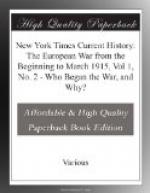* * * * *
[Illustration: State councillor Sazonof Russian Minister of Foreign Affairs. (Photo (C) by American Press Assn.)]
I.
The Russian mobilization.
In a public speech, delivered Sept. 19, the Secretary of the Treasury, Mr. Lloyd George, according to the report of The Westminster Gazette, which may be considered as his organ, characterized the quarrel between Germany and Russia in the picturesque manner which this statesman prefers, as follows:
Germany—I
insist that you stand aside with crossed arms while
Austria strangles your
little brother, (Servia.)
Russia—Just
you touch this little fellow and I will tear
your ramshackle empire
limb from limb.
We will not waste words in considering the flippant form here used in a discussion of an unspeakably bloody and world-historic conflict. But this expression in very pregnant form makes Russia appear in the light in which the London powers-that-be desire to show the empire of the Czar to the British people, viz., in the role of the noble-hearted protector of persecuted innocence, while Germany, supporting and egging on Austria-Hungary, is shown as morally responsible for the war.
Cites English Documents.
This, also, is the chain of thought in the speech of the British Prime Minister in the House of Commons on Aug. 4. Translations of this speech have been spread by the British Government in neutral countries in hundreds of thousands of copies under the title: “The Power Responsible for War Is Germany.”
Now, we claim that the British “White Paper” itself furnishes irrefutable proof that not Germany, which up to the last moment offered the hand of mediation, but Russia is responsible for the war, and that the Foreign Office at London was fully cognizant of this fact.
Furthermore, the “White Paper” shows that England’s claim that she entered this war solely as a protector of the small nations is a fable.
The documents reproduced in the “White Paper” do not begin until July 20, and only a few introductory dispatches before the 24th are given. The first of the very important reports of the British Ambassador at St. Petersburg, Sir George Buchanan, to the Secretary of State, Grey, is dated on that day; on the same day the note addressed by Austria-Hungary to the Servian Government had been brought to the knowledge of the European Cabinets, and the British Ambassador conferred with the Russian Minister of Foreign Affairs, M. Sazonof, over this matter. The French Minister also took part in this conference. When the latter and M. Sazonof, in the most insistent way, tried to prove to Buchanan that England, together with Russia and France, must assume a threatening attitude toward Austria-Hungary and Germany, the British Ambassador replied:




